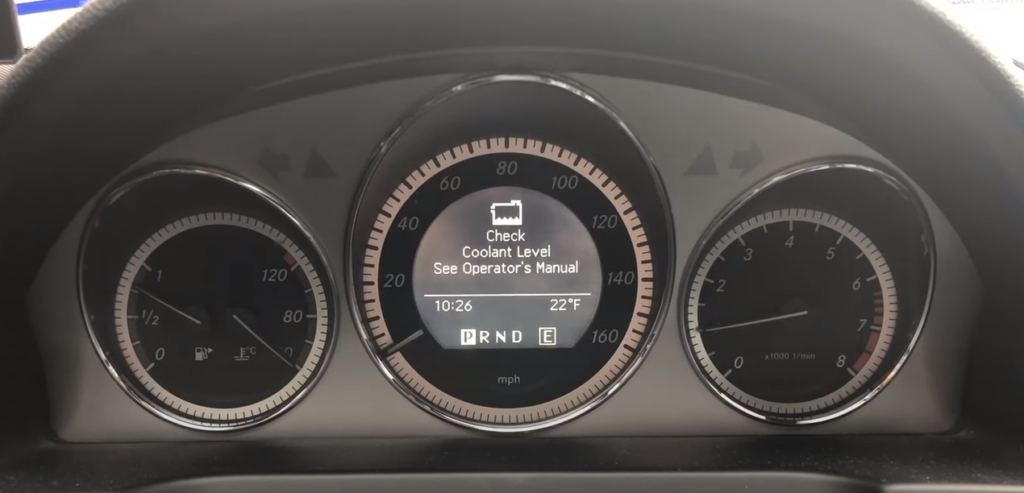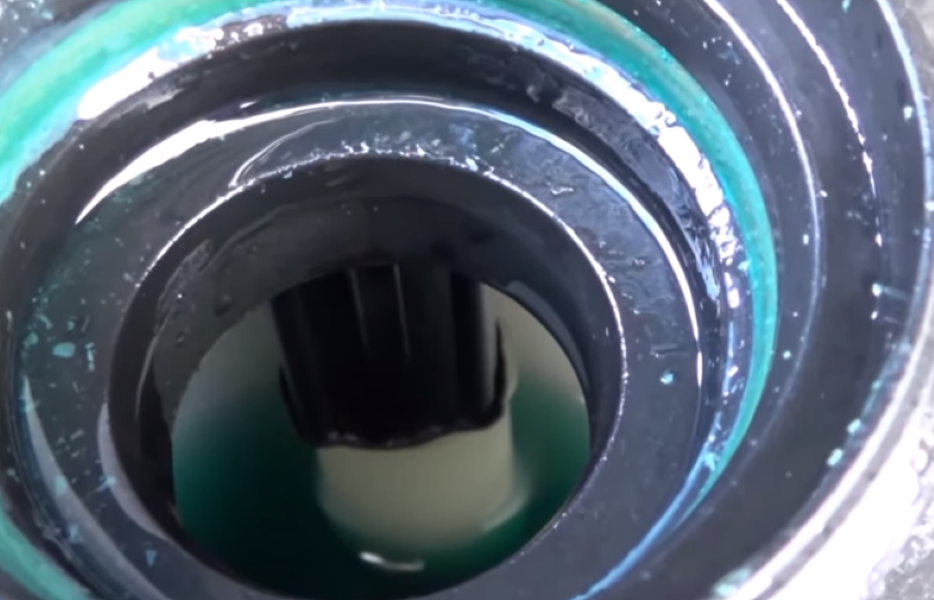Table of Contents
Engine Coolant Level Low in Mercedes: Causes, Fixes & Case Study
When the “Engine Coolant Level Low” warning appears on your Mercedes dashboard, it can feel alarming. Coolant is one of the most important fluids in your vehicle, and without it, your engine risks overheating, which can quickly lead to costly repairs.
This guide explains what low coolant means, why it happens, and the exact steps you should take. We’ll also walk through a real-world Mercedes-Benz case study to show how technicians diagnose and fix this common issue.

What is Engine Coolant and Why is it Important?
Engine coolant (antifreeze) is a specialized liquid that circulates through your car’s engine and radiator. Its main roles are:
- – Temperature regulation: Prevents overheating in summer and freezing in winter.
- – Corrosion protection: Keeps metal components like the radiator, water pump, and thermostat safe from rust.
- – System lubrication: Helps seals and moving parts within the cooling system last longer.
Without enough coolant, the engine cannot regulate its temperature properly. Even short trips with low coolant can lead to engine overheating, head gasket failure, or in severe cases, complete engine damage.
What Does the Coolant Level Low Warning Mean?
When the low coolant level warning light comes on, it means the coolant in your reservoir has dropped below the minimum safe level. This issue can occur for several reasons:
- 1. Natural evaporation: Small amounts of coolant may evaporate over time if the system isn’t perfectly sealed.
- 2. Leaks: Common at hoses, radiator, water pump, thermostat housing, or head gasket.
- 3. Faulty sensors: Sometimes the coolant level sensor malfunctions and gives a false alert.
- 4. Old or degraded coolant: Coolant that has broken down may not circulate properly, leading to reduced levels in the reservoir.
What to Do When the Coolant Level Low Warning Appears
If you see this warning while driving, follow these steps:
- 1. Pull Over Safely
Stop the car in a safe location. Driving with low coolant risks overheating and serious engine damage. - 2. Check Coolant Reservoir
Once the engine cools completely, open the hood and locate the translucent coolant reservoir. Compare the fluid against the “Min” and “Max” markings. - 3. Top Up Coolant if Necessary
If the level is below minimum, add coolant. Use only the type recommended in your Mercedes owner’s manual (typically OAT or HOAT coolant). If you are unsure, a 50/50 premix of antifreeze and distilled water is generally safe. - 4. Inspect for Leaks
Look underneath the car and around the engine bay for puddles or dried coolant stains. Common leak points include the thermostat housing, hoses, and radiator. - 5. Monitor Over the Next Few Days
After topping up, keep an eye on coolant levels. If it drops again quickly, a leak or other issue needs professional attention.
Case Study: Mercedes C-Class (M271 Engine)
Let’s look at a real-world case that illustrates how technicians diagnose and fix coolant level issues.

Owner’s Complaint
A Mercedes C-Class equipped with the M271 engine arrived at the workshop with these issues:
- – Repeated “Coolant Level Low” warning on the dashboard.
- – Visible reduction in coolant level within a few days.

Repair Procedure
1. Thermostat Housing Replacement
- – Removed the faulty housing and gasket.
- – Installed new OEM-approved components to restore a proper seal.




2. Coolant Replacement
- – Old fluid drained and replaced with fresh, manufacturer-approved coolant.
- – Air bled from the system to ensure proper circulation.
3. Final System Test
- – Reapplied pressure with the coolant tester.
- – No leaks detected; dashboard warning cleared.
Outcome
The coolant level stabilized after repair, and the low-level warning no longer appeared. The customer’s C-Class cooling system was restored to full working order, preventing overheating and ensuring reliable performance.

How to replace engine coolant ?

To replace engine coolant you should follow the next steps;
Step 1 : Drain
- 1. Remove the expansion tank cap
- 2. Remove the central and front parts of the lower engine compartment cover.
- 3. Slide the drain hose (2) onto the drain fitting at the radiator.
- 4. Open drain screw (1), drain the coolant, and collect it in a suitable container.
Step 2 : Refilling
- 1. Tighten drain screw (1) completely and remove drain hose (2).
- 2. Refill with coolant and bleed the engine cooling system.
- 3. Check the tightness of the engine cooling system.
Can You Drive With Low Coolant?
No, it’s strongly discouraged.
Driving with low coolant risks overheating, which can lead to:
- – Warped cylinder heads
- – Blown head gasket
- – Cracked engine block
- – Complete engine failure
Even a few kilometers with low coolant can cause irreversible damage. Always stop and address the issue immediately.
Preventive Measures to Avoid Low Coolant Issues
- – Regular Coolant Checks: Inspect coolant level monthly.
- – Scheduled Maintenance: Flush and replace coolant every 5 years or per Mercedes recommendations.
- – Inspect Hoses and Radiator: Look for cracks, swelling, or leaks during routine service.
- – Professional Cooling System Inspection: Have a mechanic check the thermostat, water pump, and radiator during annual servicing.
DIY vs Professional Repair
| Task | DIY-Friendly | Professional Recommended |
|---|---|---|
| Check coolant level | OK | – |
| Top up coolant | OK | – |
| Flush and replace coolant | Moderate | For complete system flush |
| Pressure test cooling system | – | OK |
| Replace thermostat housing or gasket | – | Essential |
Conclusion
The Engine Coolant Level Low warning in a Mercedes is not something to ignore. It may be a simple top-up issue, but it could also point to leaks or component failures like a thermostat housing. Left unresolved, low coolant can cause severe overheating and long-term engine damage.
By following a proper diagnostic workflow visual inspection, pressure testing, leak repair, and coolant replacement you can ensure your cooling system remains reliable. Regular maintenance and early intervention are the best ways to keep your Mercedes performing at its best.
More Mercedes Cooling System Resources
Want to explore more causes, symptoms, and repair tips for coolant leaks, overheating, and contamination?
Learn more about Mercedes cooling system faults in our full Cooling System Guide.
How to TOP UP Engine Coolant?
To top up engine coolant on a 2012 MERCEDES BENZ C Class, show the video bellow;
Frequently Asked Questions – Engine Coolant Level Low
1) What does “Engine Coolant Level Low” mean?
Your coolant in the expansion tank has dropped below the safe range. It may be a leak, evaporation, trapped air, or a faulty level sensor.
2) Can I keep driving with low coolant?
Not safely. Low coolant can cause rapid overheating and severe engine damage. Stop, cool the engine, check level, and address the cause.
3) What coolant should I use to top up?
Use the manufacturer‑approved OAT/HOAT coolant for your Mercedes (see the owner’s manual). Avoid mixing unknown types.
4) Can I use water in an emergency?
Distilled water can get you to a shop in an emergency but replace with proper coolant mix ASAP to restore corrosion and boiling protection.
5) Why did the warning come back after topping up?
There’s likely a leak (e.g., hose, thermostat housing, radiator, pump) or trapped air. Perform a pressure test to locate the source.
6) How do I check coolant level correctly?
When the engine is cold, look at the translucent reservoir and ensure fluid sits between MIN and MAX lines. Never open a hot system.
Author
Written by: Mercedes Expert
Automotive Technical Trainer & Mercedes-Benz Diagnostic Specialist
With years of hands-on experience repairing and diagnosing Mercedes-Benz vehicles, specializes in case-study-based troubleshooting guides that blend workshop accuracy with educational clarity.
Last Updated: August 2025






Leave a Reply